
Home - Search - Browse - Alphabetic Index: 0- 1- 2- 3- 4- 5- 6- 7- 8- 9
A- B- C- D- E- F- G- H- I- J- K- L- M- N- O- P- Q- R- S- T- U- V- W- X- Y- Z
Otrag
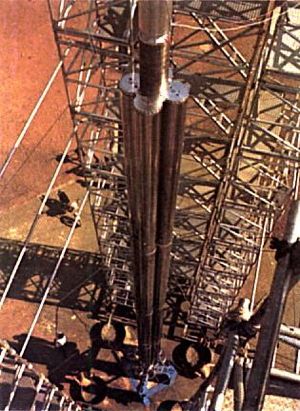 OTRAG Pad The OTRAG four-module unit mounted on its pad in the Congo. |
Status: Retired 1983. First Launch: 1977-05-18. Last Launch: 1983-09-19. Number: 18 . Payload: 1,000 kg (2,200 lb). Thrust: 1,170.00 kN (263,020 lbf). Gross mass: 100,000 kg (220,000 lb). Height: 24.00 m (78.00 ft). Diameter: 0.76 m (2.49 ft). Apogee: 185 km (114 mi).
In the early 1970's Willy Brandt's Ministry of Science and Technology solicited a contract for demonstration of launch vehicle technology an order of magnitude cheaper and more reliable than existing boosters. Lutz Kayser's research company won the contract and developed a radically new rocket technology, making more than 20 inventions in the process.
Kayser's concept involved the parallel clustering of large numbers of identical propellant tank and rocket engine modules. This allowed the application of mass production techniques as used in the automobile industry. This in turn resulted in cost reduction by a factor of 10. This breakthrough and the static testing in of prototype modules at Lampoldshausen stirred concern in the competitive aerospace industry. The established space launch companies were accustomed to making easy guaranteed profits through high cost plus fixed fee government contracts.
In order to exploit this low-cost rocket technology on a commercial basis Kayser founded OTRAG (Orbital Transport und Raketen AG) in Stuttgart. It was the world's first commercial launcher development, production and launch company.
Wernher von Braun and Kurt Debus, the leading managers of American rocketry, were so enthusiastic about the project that they joined the team after their retirement from NASA. Their contribution was important and helped to introduce lessons learned from earlier programs. Von Braun introduced the concept of parallel clustering of tanks and engines with his Saturn I design. This had shown the way towards the low-cost breakthrough 20 years earlier. However, both rocket pioneers were in doubt whether this technology should be flight tested in developing countries because of the possibility that it would be misused for weapons. Kayser optimistically hoped he would be able to limit the technology to commercial satellite launchings. He was to be proven wrong and suffered heavy financial losses as a result.
In December 1975 OTRAG signed an agreement with the Congolese government to establish a rocket range at Shaba (Katanga). Here a pad and gantry were erected and flight tests began in 1977. Logistic support was via antique British Argosy transports landing at a dirt strip on a plateau overlooking the jungle.
Kayser's activities made the great powers nervous. The USSR and France were not interested in Germany achieving an indigenous long-range rocket activity. American rocket makers were not interested in having a low-cost competitor. A propaganda campaign began, alleging OTRAG was a cover for German and South African nuclear cruise missile development. Crude Soviet-source disinformation was eagerly picked up and given credibility by the American mainstream media. The government of the Congo was pressured by the Russians to withdraw permission to use the site. OTRAG left the country in April 1979.
Soviet president Brezhnev and French president Giscard d'Estaing applied further heavy political pressure on the German government to completely cancel the project. After a total investment of $ 150 million, OTRAG had to terminate production in Germany. Tooling and materials were relocated to a new combination assembly and launch site in a remote area of the Sahara Desert, in Libya.
Another test series was begun in there in 1981. This achieved tremendous results. 14 suborbital test flights proved the concept and led to a 100% qualification of the technology and the verified the extremely low production cost. But planned 2- and 3-stage long-range tests and orbital attempts from Libya were cancelled by OTRAG when Germany became a party to the Missile Control Regime. This prohibited such tests in developing countries after 1982. Further testing of the rocket was moved to Sweden in 1983. But this action in turn led to Libyan military circles eyeing the facilities as a means of obtaining military rocket technology.
In 1983 the Libyan Government unlawfully confiscated all of OTRAG's rocket manufacturing and test equipment in the country (as it had done earlier with petroleum production facilities of Western companies). All of Kayser's attempts to obtain return of the property or to receive damages were unsuccessful (despite personal promises by Gaddafi to settle the matter lawfully). Without Kayser's know-how the Libyans were able to conduct only a few test launches with the stolen equipment. After ten years of desultory testing the Libyan program came to an end. The Libyans were apparently unsuccessful because the essential know-how and blueprints were retained by Kayser.
Kayser finally gave up trying to keep the program going in the face of such political pressure. After spending $200 million, OTRAG was shut down in 1987.
As of 2005, Kayser was actively searching for partners to fund an OTRAG-type production facility in the United States and to apply his unique low-cost technology to the requirements of the future American space program. He founded von Braun Debus Kayser Rocket Science LLC to transfer OTRAG's intellectual property and know-how to the United States. Kayser, along with newer private entrepreneurs such as Musk, Rutan, and Bezos, still dreams of achieving the goal of affordable space transport below $ 1,000 per pound into orbit.
Technical Description
Otrag rockets would have been assembled from clusters of Common Rocket Propulsion Units (originally called modules, but von Braun pointed out that the M could be construed as "Missile", further fuelling the charges of OTRAG's critics). These CRPU's properties and dimensions were optimized to achieve one and one only goal: Minimum transport cost per unit of payload mass to low earth orbit and beyond. The $ 200 million spiral development and test program took 40 years, went through more than 1000 versions, included over 6000 static tests firings with total burning time approaching one million seconds, and achieved 14 suborbital test flights. The CRPU was human-rated and had a confidence level higher than 6-sigma. Main characteristics were:
- Thrust: 25,000 N (5,000 lbf)
- Oxidizer: High Density Acid (HDA) (50% N2O4- 50% HNO3) Den: 1.66 gr/cm^3
- Fuel: Diesel fuel or Kerosene
- Specific Impulse: First stage - 270 seconds, Stages 2 and 3 - 297 seconds vacuum
- Injection pressure: 40 - 15 bar
- Thrust control: 100% - 40 %
- Pressurization: Compressed air, 66% tank filling in blow-down mode
- Injector: Radial like on like
- Chamber cooling: Ablative phenolic
- Mass total: 1,500 kg
- Mass empty: 150 kg
- Material of injector, valves, bulkheads: AlMg5
- Material of cylindrical tank sections: cold-rolled low-carbon stainless steel
- Dimensions: Diameter 0.27 m, Length: 16 m
The following nominal vehicles were planned for applications from LEO to lunar landing and beyond: (at a conservative 70% payload utilization):
| Vehicle | LEO-payload metric tons | Launch mass metric tons | Cost: $ million (2005) |
| KAYSER 1 | 1 | 100 | 2.5 |
| KAYSER 2 | 2 | 200 | 5 |
| KAYSER 4 | 4 | 400 | 10 |
| KAYSER 8 | 8 | 800 | 20 |
| KAYSER 16 | 16 | 1.600 | 40 |
| KAYSER 32 | 32 | 3.200 | 80 |
| KAYSER 64 | 64 | 6.400 | 160 |
| KAYSER 128 | 128 | 12.800 | 320 |
Parallel staging allowed very large payload diameters up to 30 m and thrust acceleration to be limited to a maximum of 3 g to allow lighter payload and space vehicle structures. The low cost was mainly achieved by simple design, lack of moving components, cheap commercial materials and components, and large volume production of tens of thousands CRPU's per year.
In principle, the first and second stage clusters could easily be recovered on land or sea. However, the very low mass production cost of $25,000 per CRPU and the estimated recovery and refurbishing cost of $20,000 per CRPU could be used to justify either expendable or reusable units. Adding the complexities of a recovery system and the lower reliability of aging/refurbished equipment tipped the scale toward expendable operation until enough experience was accumulated in the first ten years of operation.
It was assumed that this propulsion breakthrough, based on more than 20 inventions, would achieve an absolute minimum in transportation cost. This would have allowed OTRAG to win the majority of launch contracts. In US Government procurements OTRAG expected to be able to underbid any competitor. It was expected that private entities would turn to OTRAG, because low cost was a necessary condition for future markets such as space tourism and lunar mining.
LEO Payload: 1,000 kg (2,200 lb) to a 185 km orbit at 0.00 degrees. Launch Price $: 20.000 million in 2005 dollars.
Stage Data - Otrag
- Stage 1. 48 x Otrag. Gross Mass: 1,500 kg (3,300 lb). Empty Mass: 150 kg (330 lb). Thrust (vac): 26.960 kN (6,061 lbf). Isp: 297 sec. Burn time: 140 sec. Isp(sl): 240 sec. Diameter: 0.27 m (0.88 ft). Span: 0.27 m (0.88 ft). Length: 16.00 m (52.00 ft). Propellants: N2O4/Kerosene. No Engines: 1. Engine: Otrag. Other designations: CPRU. Status: Out of Production. Clustered to form Otrag launch vehicles. Pressure-fed, using cheapest possible propellants. Injection pressure: 40 - 15 bar; Thrust control: 100% - 40 %; Pressurization: Compressed air 66% tank filling in blow-down mode; Injector: Radial like on like; Chamber cooling: Ablative phenolic; Material of injector, valves, bulkheads: AlMg5; Material of cylindrical tank sections: cold rolled low carbon stainless steel.
- Stage 2. 12 x Otrag. Gross Mass: 1,500 kg (3,300 lb). Empty Mass: 150 kg (330 lb). Thrust (vac): 26.960 kN (6,061 lbf). Isp: 297 sec. Burn time: 140 sec. Isp(sl): 240 sec. Diameter: 0.27 m (0.88 ft). Span: 0.27 m (0.88 ft). Length: 16.00 m (52.00 ft). Propellants: N2O4/Kerosene. No Engines: 1. Engine: Otrag. Other designations: CPRU. Status: Out of Production. Clustered to form Otrag launch vehicles. Pressure-fed, using cheapest possible propellants. Injection pressure: 40 - 15 bar; Thrust control: 100% - 40 %; Pressurization: Compressed air 66% tank filling in blow-down mode; Injector: Radial like on like; Chamber cooling: Ablative phenolic; Material of injector, valves, bulkheads: AlMg5; Material of cylindrical tank sections: cold rolled low carbon stainless steel.
- Stage 3. 4 x Otrag. Gross Mass: 1,500 kg (3,300 lb). Empty Mass: 150 kg (330 lb). Thrust (vac): 26.960 kN (6,061 lbf). Isp: 297 sec. Burn time: 140 sec. Isp(sl): 240 sec. Diameter: 0.27 m (0.88 ft). Span: 0.27 m (0.88 ft). Length: 16.00 m (52.00 ft). Propellants: N2O4/Kerosene. No Engines: 1. Engine: Otrag. Other designations: CPRU. Status: Out of Production. Clustered to form Otrag launch vehicles. Pressure-fed, using cheapest possible propellants. Injection pressure: 40 - 15 bar; Thrust control: 100% - 40 %; Pressurization: Compressed air 66% tank filling in blow-down mode; Injector: Radial like on like; Chamber cooling: Ablative phenolic; Material of injector, valves, bulkheads: AlMg5; Material of cylindrical tank sections: cold rolled low carbon stainless steel.
| Otrag CPRU N2O4/Kerosene propellant rocket stage. Clustered to form Otrag launch vehicles. Pressure-fed, using cheapest possible propellants. |
Family: LCLVs, low cost, orbital launch vehicle. Country: Germany. Launch Sites: Kiruna, Kapani Tonneo, Tawiwa. Stages: Otrag CPRU. Bibliography: 2, 2000, 2001, 572.
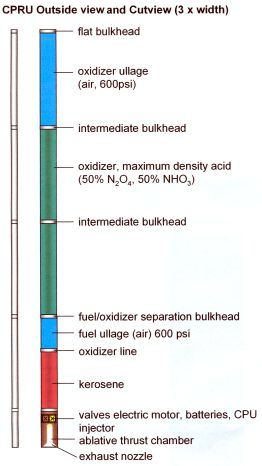 | Otrag Stage Cutaway Credit: courtesy Lutz Kayser |
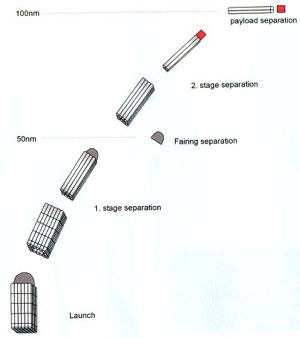 | Otrag Staging Credit: courtesy Lutz Kayser |
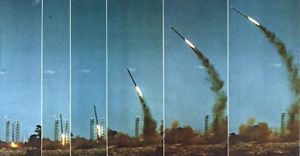 | OTRAG First Launch OTRAG first launch - went off course when one of the four modules failed to ignite. |
 | OTRAG Argosy support Antique Argosy transports provided logistics support for the program, in keeping with its low-cost, low-tech approach. |
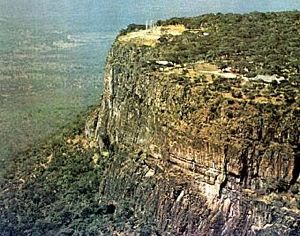 | OTRAG Congo Launch S |
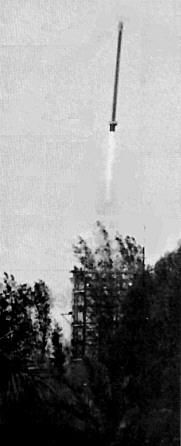 | OTRAG Libya Launch S Launch site was located in the Seba Oasis 800 km south of Tripoli. |
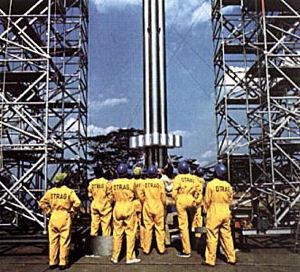 | OTRAG Pad Workers' (or at least locals in OTRAG coveralls) cluster around the four-module launch vehicle at the pad in Zaire |
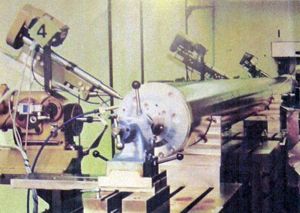 | Otrag Module in Shop Credit: courtesy Lutz Kayser |
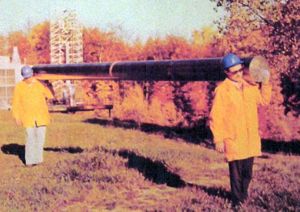 | Otrag Module at Site Credit: courtesy Lutz Kayser |
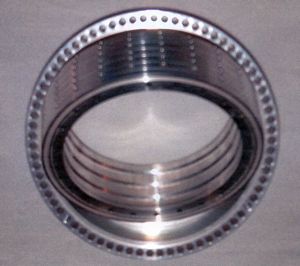 | Otrag Hardware Credit: courtesy Lutz Kayser |
 | Lutz Kayser Credit: courtesy Lutz Kayser |
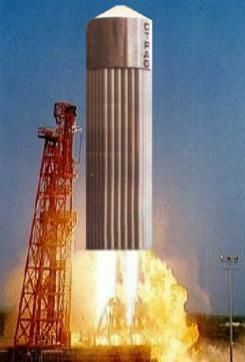 | Otrag 10K |
1977 May 18 - . 08:15 GMT - . Launch Site: Kapani Tonneo. Launch Vehicle: OTRAG.
- Otrag Flight 1 - . Nation: Germany. Agency: OTRAG. Apogee: 15 km (9 mi). Four-module test vehicle, 6 m long. Propulsion test. Reached 20 km altitude. 100% successful..
1978 May 19 - . 22:01 GMT - . Launch Site: Kapani Tonneo. Launch Vehicle: OTRAG.
- Otrag Flight 2 - . Nation: Germany. Agency: OTRAG. Apogee: 30 km (18 mi). Four-module test vehicle, 6 m long. High altitude night test. Reached 150 km altitude..
1978 June 5 - . 11:40 GMT - . Launch Site: Kapani Tonneo. Launch Vehicle: OTRAG. FAILURE: Failure. Heeled over and crashed after a few seconds.. Failed Stage: 1.
- Otrag Flight 3 - . Nation: Germany. Agency: OTRAG. Apogee: 0 km (0 mi). Four module test vehicle, 12 m long. Pitch and yaw control test. Attempt to reach 100 km, but veered off course on launch due to a valve on one unit being stuck at 50% thrust..
1981 March 1 - . 09:20 GMT - . Launch Site: Tawiwa. Launch Vehicle: OTRAG.
- Otrag Flight 4 - . Nation: Germany. Agency: OTRAG. Apogee: 150 km (90 mi). Maximum range single stage test, reached 300 km..
1981 June 7 - . Launch Site: Tawiwa. Launch Vehicle: OTRAG.
1981 September 17 - . Launch Site: Tawiwa. Launch Vehicle: OTRAG.
1981 October 1 - . Launch Site: Tawiwa. Launch Vehicle: OTRAG.
1981 October 24 - . Launch Site: Tawiwa. Launch Vehicle: OTRAG.
1981 November 19 - . Launch Site: Tawiwa. Launch Vehicle: OTRAG.
1981 December 12 - . Launch Site: Tawiwa. Launch Vehicle: OTRAG.
1982 June 2 - . Launch Site: Tawiwa. Launch Vehicle: OTRAG.
1982 June 24 - . Launch Site: Tawiwa. Launch Vehicle: OTRAG.
1982 September 2 - . Launch Site: Tawiwa. Launch Vehicle: OTRAG.
1982 September 11 - . Launch Site: Tawiwa. Launch Vehicle: OTRAG.
1982 November 10 - . Launch Site: Tawiwa. Launch Vehicle: OTRAG.
1982 November 16 - . Launch Site: Tawiwa. Launch Vehicle: OTRAG.
1982 December 9 - . Launch Site: Tawiwa. Launch Vehicle: OTRAG.
1983 September 19 - . 05:59 GMT - . Launch Site: Kiruna. Launch Vehicle: OTRAG. FAILURE: Failure. Failed Stage: 1.
- Otrag Flight 18 - . Nation: Germany. Agency: DLR, OTRAG. Apogee: 4.00 km (2.40 mi). 1-3-B 4x9m Test mission.
Back to top of page
Home - Search - Browse - Alphabetic Index: 0- 1- 2- 3- 4- 5- 6- 7- 8- 9
A- B- C- D- E- F- G- H- I- J- K- L- M- N- O- P- Q- R- S- T- U- V- W- X- Y- Z
© 1997-2019 Mark Wade - Contact
© / Conditions for Use